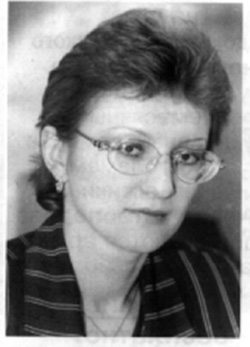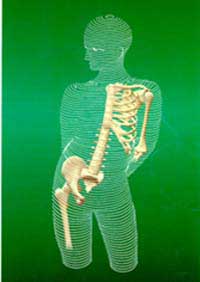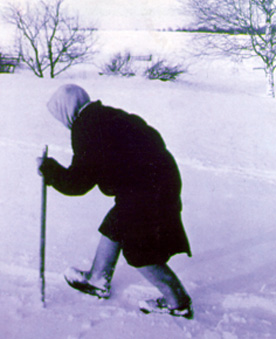
![]()
- Osteoporosis: a"Mute" Epidemic

|
|
|
| Until the recent past, the problem of osteoporosis presented an interest to only a narrow circle of specialists - the scientists, and was only vague concept for the majority of doctors. Understandably, the prophylaxis and the treatment of osteoporosis was not paid much attention either. But this illness in fact underlies the invalidity and a premature death of many elderly people; it is a serious medical, ethical, social and economic problem. Today our readers meet Irina Anatolyevna Skripnikova, Seniour Researcher at the State Scientific-Research Center of Prophylactic Medicine. |

On the photo: Irina Skripnikova |
Q.: What is osteoporosis?
I.S.: Osteoporosis is a systems illness of the skeleton, characterized by a decrease of the bone mass and by a deterioration of the bone tissue microarchitectonics, which leads to a higher bone brittleness and to a further increase of the risk of bone fractures. Osteoporosis comes from the words, "a porous bone". With an advance in the age, as the locomotor system in any person succumbs as a result of the natural process of ageing and as calcium is washed out of it, the bone mass decreases, with an annual loss comprising approximately 1 per cent of the peak bone mass. In women during the period of the menopause, when the ovaries work out an insufficient amount of estrogens - the hormones, taking an active part in the bone metabolism process, the loss of the bone mass may even amount to an annual 4 or 5 per cent, and this, in turn, leads to the bone brittleness and to bone fractures. As a rule, this illness strikes elderly women in the first five or ten years after the setting in of the menopause. According to the statistics, the risk of various kinds of fractures in connection with the reduction of the bone mass in a 50 year old woman amounts to 40 per cent of those threatening her in the rest of her life. |
Q.: What is the scale of the spread of osteoporosis in this country?
Q.: Who is engaged in the osteoporosis studies in Russia?
|
I.S.: In this country, the problems, involved in the treatment and in the prophylaxis of this illness, are tackled by the Institute of Rheumatology, by the State Scientific-Research Centre of the Prophylactic Medicine, by the Institute of Traumatology and Orthopedics, and by the Institute of Endocrinology. The problem of osteoporosis in fact concerns a great many specialists - orthopedicians, endocrinologists, rheumatologists, gerontologists and roentgenologists, since this malady accompanies many other illnesses. Presently, by an order of the Ministry of Public Health, a federal centre for studying osteoporosis is created at the Institute of Rheumatology. And in 1995, the Russian Association on Osteoporosis, presided by Prof. Lydia Ivanovna Benevolenskaya, was established, which today unites 46 regional branches. The Association has elaborated and submitted to the Ministry of Public Health of the Russian Federation proposals on setting up the centres for diagnosing and rendering specialized assistance on osteoporosis, based on large multi-profile hospitals, where the efforts of doctors of the most variegated specialities, all of whom are to this or that extent concerned with osteoporosis, can be easily joined. |
 |
Q.: Until recently, only a few people were aware of osteoporosis. The majority of the population has no concept of this illness even now. But the contemporary information about this malady will make a certain part of people take care of their health. Who is engaged in the spread of the information on osteoporosis here in Russia today?
Q.: You have mentioned the risk group. Who is embraced by it?
I.S.: The risk group embraces the women of a delicate constitution with a pale skin, who are childless or have one or two children, and who have the backbone or the neck of the femur fractures in the family chronicles. Fat women are more lucky: it is commonly believed that after the menopause, the fatty tissue partially assumes the ovaries' functions, producing the necessary hormones to compensate for the shortage of estrogens. Women with an artificial or with an early menopause are also included into the risk group.
Q.: What are the distinct symptoms of this malady?
 |
Q.: What is the prophylaxis of the illness?
I.S.: The prophylactic measures must be started as early as possible. In the juvenile and in the young age the peak of the bone mass is formed, with the maximum reached by 25 or 30 years. The higher the peak, the more bone mass remains in the latter half of life. This peak may be considerably raised at the expense of consuming foodstuffs with a high content of calcium; an average 1,000-1,500 mg of calcium must enter the organism daily. There is a direct link between the strong tonus of the muscles and a good condition of the bone tissue. For this reason, regular physical jerks and the sports in the period of the bones growth facilitate an increase of the peak of the bone mass. Sunbathing in reasonable doses helps to accumulate Vitamin D, which is also involved in the bone metabolism and promotes the intestinal absorption of calcium and the maintenance of its normal level in the organism. |
The State Scientific-Research Centre of the Prophylactic Medicine, where you can undergo an examination and will be given the consultations you need, is situated at the address: 10, Petroverigsky Lane, Moscow. Telephone: 927-03059.
Irina Skripnikova interviewed by Elena Chernomazova
|
|